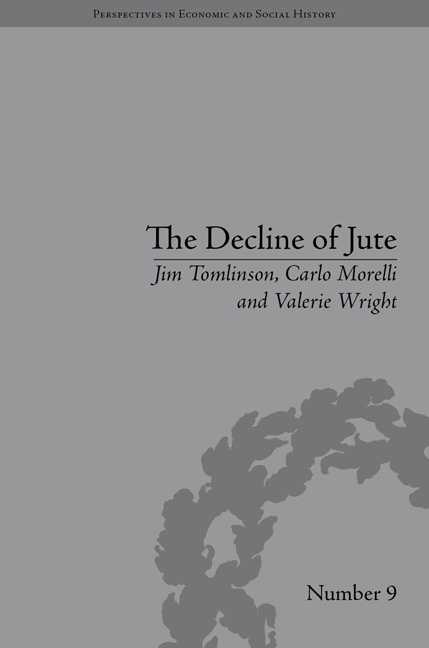Book contents
- Frontmatter
- CONTENTS
- Dedication
- Acknowledgements
- Abbreviations
- List of Figures and Tables
- Introduction
- 1 The Story up to 1939
- 2 De-Globalization and Decline, 1939–99
- 3 The Industry and its Workforce
- 4 Defending the Domestic Industry
- 5 Firms’ Responses to the Decline of the Industry
- 6 Influencing Government
- 7 The Decline of Jute and the Economic Health of Dundee
- Conclusions
- Notes
- Works Cited
- Index
Conclusions
- Frontmatter
- CONTENTS
- Dedication
- Acknowledgements
- Abbreviations
- List of Figures and Tables
- Introduction
- 1 The Story up to 1939
- 2 De-Globalization and Decline, 1939–99
- 3 The Industry and its Workforce
- 4 Defending the Domestic Industry
- 5 Firms’ Responses to the Decline of the Industry
- 6 Influencing Government
- 7 The Decline of Jute and the Economic Health of Dundee
- Conclusions
- Notes
- Works Cited
- Index
Summary
The decline of jute in Dundee has an air of inevitability. An unsophisticated product, with a large part of its costs of production comprising a foreign-grown raw material, it was unsurprisingly subject to devastating competition from producers in developing countries who could (with a little help from Dundonians) successfully enter the industry, using local raw materials. Yet, as we have sought to show, the story of jute's decline in Dundee is not a simple story of the undermining of ‘juteopolis’ by low-cost competitors. The industry responded pro-actively and in a range of ways to its problems. Even before the First World War it was moving its products away from the bags and sacking which dominated in the period of the extraordinary growth of world trade in primary products after 1870. At the same time it sought protection for the industry, a search which was only ultimately successful in 1939 because of the contingencies of war – always a powerful force in the industry's fortunes.
While the industry thereafter sought to make protection permanent, it could not and did not couple this defensive posture with neglect of the need for ‘modernization’ and diversification. Central to the story of post-war jute is the interaction of these two imperatives
At a meeting of the AJSM in May 1977 the jute employers sought to challenge the analysis of the industry's recent past put forward in a draft of the McDowall Report in dialogue with the authors of the Report.
- Type
- Chapter
- Information
- The Decline of JuteManaging Industrial Change, pp. 155 - 164Publisher: Pickering & ChattoFirst published in: 2014



